
Recently on Cyclingnews.com |
Interbike Show
Las Vegas, Nevada, USA, September 24 - 28, 2007
Main Page Previous Part Next Part
Part 6: Carbon, carbon, and more carbon
By James Huang
Easton reinvents its wheel line
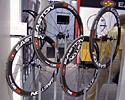
|
Easton has revamped its entire line of wheels for 2008, with some models enjoying just a modest refresh or tweak, but others a complete ground-up overhaul. Sitting at the top of the road range are the four carbon-rimmed models of the EC90 line. The versatile EC90 Aero Carbon sports 56mm-deep tubular rims laced to Easton's own R4 hub design with straight-pull Sapim double-butted spokes (18/20h f/r). The EC90 TT Carbon variant is nearly identical, but swaps the standard R4 front hub for an R4TT version that uses narrower spoke flanges and airfoil-shaped end caps for reduced drag, and also cuts the front spoke count by two. Claimed weight for both wheelsets is just 1370g.
A lighter EC90 SLX Carbon version is also available which uses a shallower 24.9mm deep tubular rim for when the road points skyward (or when the crosswinds pick up) and similar R4 alloy hubs. Spoke counts actually go up to 18/24h f/r, but the shallower rim drops the overall weight down to just 1170g for the pair.

|
Trackies get the new EC90 TKO Carbon, which borrows the EC90 Aero's 56mm-deep rims but uses a pair of awesome-looking large-flange and aero-sleek R4 hubs that incorporate a trick splined attachment for the Easton-specific cogs. The 18/20h f/r Sapim double-butted spokes help ensure a snappy response, and the 1545g wheelset weight probably won't hurt, either.
The EA90 line is similarly broad, with four aluminum-rimmed clincher models for 2008. The EA90 Aero uses a differential rim profile to improve crosswind handling and ride quality (26mm front, 32mm rear), but Easton's R4 hubs still manage to keep the weight reasonably low at 1545g per pair. Just as on the carbon version, the EA90 TT swaps the standard R4 front hub for the aero-profiled R4TT, and the EA90 SLX drops the section depths to just 21/25mm front/rear to post a 1472g wheelset weight. Riders looking for a beefier option can turn to the EA90 SL, which uses the same 21/25mm rims but jacks the spokes count up to 24/28h front/rear for better response and durability.

|
Things are definitely cooking in the off-road kitchen as well, as Easton will now offer singlespeed and 29" versions of its well-received XC One, as well as a dedicated DH wheelset. The as yet unnamed XC One singlespeed rear wheel uses a shortened freehub body to allow for some chainline adjustment, and the spoke flanges are pushed outwards to increase lateral rigidity. Spoke flanges are also pushed out wide on the new DH wheelset, which also used longer butts on the 2.35/2.0mm stainless steel spokes to increase stiffness by a reported 35-40% over Easton's existing Havoc model.
Handlebars and stems have also received some attention, highlighted by the new EC90 SLX³, with its gradual semi-anatomic bend, and the decidedly more radical EC90 Aero, which incorporates molded-in finger grooves and a more extreme anatomic drop section. All aluminum stems now utilize Easton's new Top-Lock keyed face plate configuration which is said to yield a stronger and stiffer interface, especially with carbon bars.
As if that weren't enough, Easton will also launch a particularly promising-looking EC90 carbon crank, built with hollow CNT-enhanced carbon composite to yield a claimed best-in-class stiffness-to-weight ratio. Easton still has to iron out a few details, but preliminary specs suggest a paltry 545g weight for the arms and chainrings, plus another 95g or so for the bottom bracket cups. Even with substantially-sized arms, though, Easton claims the EC90 will have a 2mm-narrower Q-factor than Shimano's Dura-Ace model, and will retail for under US$600 without the bottom bracket. Tasty. We'll take two, please.
FSA sets sail for quicker times
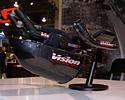
|
We've already shown you the highlights of FSA's 2008 lineup at Eurobike, but the firm's Vision arm still held a neat-looking concept up its sleeve at this year's Interbike show. The as yet unnamed 'drink system' utilizes a boat hull shape made of thermoplastic and carbon fiber to hold a dual bladder system and a pair of bendable straws, allowing users to take in water and electrolyte drinks without having to break from the aero tuck.
Sure, the bottle-on-the-aero b ar concept has already been done to some extent, but FSA claims its system may actually reduce course times by redirecting airflow around the usually turbulent head tube area. So far, FSA says that USAT has approved the concept for use in its sanctioned triathlons, but it remains to be seen where else it will be allowed. No word yet on costs or weights, but we'll be keeping our eyes on this one.
Parlee and KGS Bikes aim for stratosphere
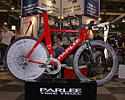
|
Parlee showed off a prototype version of its sharp-looking TT bike last year but said that production is finally in full swing this year. The full-custom all-carbon frame is said to have taken a full year to develop, and in spite of its deep tube sections, supposedly offers a ride quality similar to that of Parlee's venerable Z1 road frame.
Other aero touches include the requisite internal cable routing and a clever telescoping aero-section carbon seatpost that offers much of the benefit of fully integrated designs but without some of the hassles. Parlee says it also plans to offer a stock version of the TT, as well as an offshoot designed for road use.
Parlee also displayed a pair of bona fide showstoppers this year, both built in collaboration with Texas retailer KGS Bikes. Store owner Kevin Saunders commissioned the stunning Z1's as 'proof of concept' machines, to demonstrate to his decidedly well-to-do customers what was possible. Custom touches include a head-to-toe matching paint job, including on the carbon chainrings, bottle cages, and Record kit. What does such as machine cost, you ask? Saunders estimates the red-and-black one on display to command approximately US$27,000.
Perhaps a bit outrageous, you say? Maybe, but if you're a well-heeled empty-nested baby boomer looking for a top-end toy, this is a hell of a lot cheaper than dropping coin on an exotic car, a fast boat, or a raging coke habit. When you think about it, it's really not all that different from buying a Honda Accord in terms of cost, but the experience is more akin to a custom Lamborghini. That doesn't necessarily mean that we don't think it's outrageous, too, but we still want one.
Delta 7 Sports officially debuts IsoTruss technology
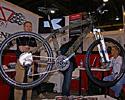
|
We first spotted Tyler Evans' unusual creation outside the halls of that year's Interbike show and were thoroughly convinced that the innovative concept not only deserved a further look, but could very well have a significant impact on the landscape of composite bicycle frames.
My, my, what a difference three years make. What began as a student project under Prof. David W. Jensen at the Center for Advanced Structural Composites at Brigham Young University is now a full-blown company with a polished-looking final product and scores of enquiring bicycle engineers and product managers knocking at the door of recently formed Delta 7 Sports.
The heart of the Delta 7 Arantix is its unique IsoTruss design, which Evans says is a far more efficient structure for carbon fiber than closed tubes. The patented 'open lattice' design supposedly delivers greater rigidity and strength, while also utilizing less material and providing more tunability. The unique geometry also keeps fibers mostly straight, where they are most effective, and the relatively thick cross-sections of each section make for superb impact resistance. The redundant nature of IsoTruss also means that one (or more?) short span can be completely broken without suffering much consequence overall.
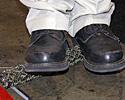
|
The finished product is undeniably striking, and is said to be outrageously rigid (a good or a bad thing, depending on what you're looking for). It's not incredibly lightweight at 1.25kg (2.75lb), but it carries no weight limit and its purported strength would likely make it appealing for larger and more abusive riders. However, those larger and abusive riders would probably balk at the Arantix's US$7000 asking price, so justified due to the immense amount of labor required to build the frame (estimated at 300 hours each). Not surprisingly, Delta 7 is limiting production to just 150 to 200 frames annually.
What's far more interesting than the frame itself, though, is where this technology can go from here. The idea of an ultralight and ultra-stiff carbon structure that is also immensely damage-tolerant has enormous implications for other frame designs, particularly if IsoTruss is integrated into existing and proven platforms. Will we see 5lb freeride frames in the near future? Or maybe sub-4lb cross-country full-suspension frames that can actually hold up to real world abuse? Perhaps. We'll have to wait and see. In the meantime, look for ride report on the Arantix over the next few months.
Photography
For a thumbnail gallery of these images, click here
Images by James Huang/Cyclingnews.com
- Easton cheats the wind with its EC90 Aero and EC90 TT wheelsets.
- The aero front hub uses narrower flanges for reduced frontal area and airfoil-shaped endcaps.
- Ouch! Astana rider Steve Morabito was involved in a nasty wreck…
- …and only at the finish of the race did he realize that there was a gaping hole in the side of his rim! Nice testament to strength of Easton's carbon rims, eh?
- The EC90 SLX is Easton's lightest model at just 1170g for the pair.
- Easton's R4 hub design uses a large diameter aluminum axle…
- …adjustable bearing preload , and a relatively fast-engaging 32-tooth freehub ratchet.
- The EC90 TKO is ready to hit the velodrome.
- Easton's proprietary spline attachment system makes for easy cog swaps.
- Easton introduces a tubular version of its workhorse EA70 wheelset for 2008.
- The relatively light weight and reliability of the EA70X aluminum rim should make it an easy choice for cyclocross.
- The EA70 SL wheels use a higher spoke count for increased rigidity and durability.
- The EA70 line uses Easton's older R3 hub design.
- The Easton EA50 wheelset offers an excellent value.
- The EA50 wheels get upgraded to aluminum freehub bodies for 2008.
- Easton expands the XC One cross-country wheelset lineup to include a 29" version…
- …as well as a singlespeed-specific rear wheel.
- The singlespeed version of the XC One uses a short freehub body that allows for flexible chainline adjustment.
- The new XC Two offers much of the performance of the higher-end XC One but at a significantly lower price point.
- Easton showed off an early sample of its new DH-specific wheelset.
- The spoke flanges of the new DH front hub are pushed out as far as possible to maximize lateral rigidity.
- The Havoc rear hub can be used with 12mm thru-axle setups…
- …or bolt-on applications with the new retrofit kit.
- All of Easton's aluminum stems now incorporate the Top-Lock keyed face plate design.
- According to Easton, the lightest XC setup is provided by its oversized EA90 stem and standard-diameter flat bar, joined together with its new composite shim.
- The Easton Equipe SLX³ bar uses a new semi-anatomic bend that better accommodates a wider variety of levers.
- The EC90 Aero bar is decidedly more radical with a flat drop section and finger grooves.
- Easton also plans to launch a new carbon crankset which supposedly offers the best strength-to-weight ratio of any major competitor.
- FSA's new 'drink system' looks a bit funny but supposedly smooths airflow around the usually turbulent head tube.
- The 'drink system' bears distinct resemblance to a boat hull.
- Dual bladders separate plain water from electrolyte drink.
- A wind's-eye view of FSA's new 'drink system'.
- Dual flexible straws mean that riders will be able to take in fluids without breaking from the aero position.
- The versatile attachment system will be able to accommodate a wide variety of aero setups.
- A small bag at the rear of the 'drink system' can be used to store gels, tools, or other items.
- Parlee's razor-edged TT frame is finally ready for production.
- In spite of the deep aero tube sections , Parlee says the TT delivers a near-Z1-like ride quality.
- Not much to see here , at least as far as the air is concerned.
- The Parlee TT incorporates a semi-integrated seatpost…
- …but a short telescoping section up top makes for easy adjustment.
- A deep cutout behind the seat tube is ready to swallow up rear wheels.
- Airflow should supposedly flow smoothly around the bottom bracket shell.
- In typical Parlee fashion , the TT frame includes a slick front derailleur mount.
- Internal cable routing keeps control lines out of the way.
- This showstopper commanded a retail price of US$27,000. Sign us up.
- Nearly every part of this machine was custom-painted to match…
- …including the saddle and post…
- …carbon bottle cages…
- …carbon brakes…
- …carbon crankset (and chainrings!)…
- …Campagnolo Record rear derailleur…
- …and even the Ergopower levers. Wow.
- This Parlee was hand airbrushed a fantastic blue hue.
- Good luck finding this level of detail on your typical showroom floor.
- Um… there's a lot of stuff missing from this bike, right?
- Nope. The new Delta 7 Arantix uses a patented IsoTruss structure instead of conventional tubes.
- The IsoTruss tubes on the Delta 7 Arantix are more air than carbon.
- Control lines simply pass right through the 'tubes'.
- Currently, the IsoTruss structure is incredibly labor-intensive , as each joint is hand-wrapped with Kevlar.
- The redundant structure of the IsoTruss design helps the frame slough off impacts that would cripple other frames.
- Beefy carbon fiber sections join the IsoTruss members.
- The bottom bracket shell looks positively tiny as compared to the massive IsoTruss sections.
- Who needs cable stops?
- Get used to seeing this logo. It may not be on this frame per se, but IsoTruss has a bright future ahead of it.
- Cleanly CNC-machined dropouts include a replaceable derailleur hanger.
- Can you do this to your frame?
